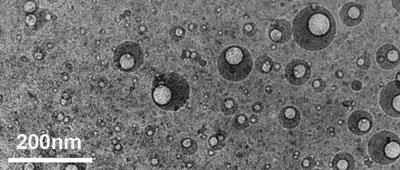Stable, nanoscale water-in-oil-in-water emulsions could deliver double hits of drugs
US scientists have made nanoscale water-in-oil-in-water (WOW) emulsions that could have important applications in drug delivery.
Timothy Deming and colleagues at the University of California, Los Angeles, have created the first double emulsions to contain droplets just 10 to 100 nanometres in diameter - in the range required to ferry drugs into cells. Crucially, a stable mixture of oil and water droplets would allow drug designers to combine polar and non-polar therapeutic molecules in a single treatment.
The researchers are able to form their nanoscale emulsions, and keep them stable for months at a time, by adding copolypeptide surfactants. These surfactants - long chain molecules, polar at one end and non-polar at the other - straddle the oil-water interface, and are designed to make the oil layer harder to breach from the inside, says Deming. ’So the inner droplets are trapped - they can’t get out to the bulk phase,’ he adds.

The key feature of these surfactants is that their hydrophobic end, which sits in the oil layer, is made from a mixture of L- and R-amino acid enantiomers. This makes their 3D structures more irregular and frees up hydrogen bonding groups that would otherwise be involved in keeping each molecule wound in a tight helix. Mixed enantiomer peptide chains form more inter- rather than intramolecular hydrogen bonds, so the chains can pack closely together at the outer interface of the oil layer, preventing the inner water droplet from escaping.
Using the surfactant, Deming’s team were able to form microscale WOW emulsions with a simple handheld homogeniser. But to achieve nanosized droplets, they passed the microscale emulsions through a microfluidic device, which smashes jets of the liquid together, shearing the tiny droplets to produce even smaller ones.
Dipak Sarker, who researches nanoscale systems for drug delivery at the University of Brighton, UK, says the study showcases some excellent delivery designs. However, he worries about the safety of the molecules involved. ’They’re talking about making these architectures, but they don’t mention the fact that some of these polymers are toxic, and that’s a reason why they’re not used much,’ says Sarker.
Deming argues that toxicity can be advantageous in some cases, such as in antimicrobials used to kill bacteria. But he admits it will take years of development to design safe therapeutics. In the future, he says similar systems could be used to deliver double hits of anti-cancer molecules to tumour cells. ’A lot of the traditional anti-cancer drugs are hydrophobic molecules and so we can load those into the oil phase, but we can also load a therapeutic RNA molecule, which is water soluble, into the central aqueous phase. So we would have a combination therapy with a sort of a one-two punch to knock the cells out.’
Hayley Birch
Enjoy this story? Spread the word using the ’tools’ menu on the left.
References
J A Hanson et alNature, 2008, 455DOI: 10.1038/nature07197)






No comments yet